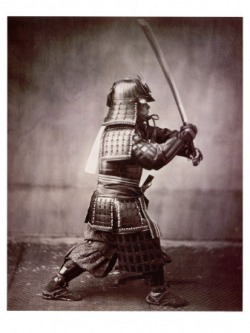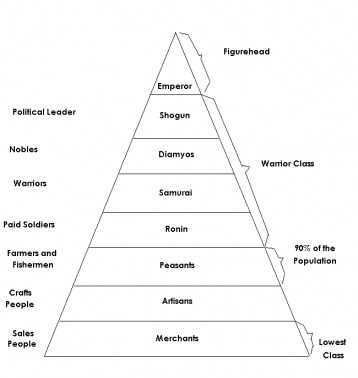Feudalism in Japan

Samurai
The feudalism in Japan was all basically a fight for more land, more wealth, and above all, more power. When the government became weaker, large landowners had much power, and fought amongst themselves for each other’s land. This was the feudalism in Japan.Even after Prince Shotoku, a strong and wise leader, died, Japan still remained relatively peaceful and united. The emperor was still at the head of the central government, but in reality, did not rule.During the Edo period, from 800 to the 1200s, beauty was sought out as much as possible. However, due to the sudden interest in beauty, the government weakened, bringing ambitious landowners more power. In the 800s, a powerful family of nobles, the wealthy Fujiwara clan, became the real rulers of Japan; they held all of the power. This stayed the same for 300 years.During the 1100s, both the Fujiwara clan and the central government started to fall, due to the fact that the government was running out of money. This resulted in the government losing their authority over large estate owners, or daimyo.Daimyo are Japanese lords who own large landholdings and a private samurai army, and pay no taxes. Daimyo hired many samurai warriors for protection, and to attack other daimyo for their land and wealth. Several civil wars occurred, because o the daimyo fighting each other. There were several powerful families that had huge armies of samurai, and therefore more power. These families included the Taira and the Minamoto.As the power of the daimyo increased, the government continued to weaken, and trouble started to occur. People such as peasants and merchants, people who owned small portions of land, began to pledge their loyalty to the powerful daimyos, in exchange for protection. Their loyalty usually included military service, but sometimes, farmers who were unable to fight gave the daimyo food and supplies for the army.Anybody who pledged loyalty to a daimyo, and received protection and land in return, was called a vassal. This marked the start of feudalism. As more vassals joined a daimyo, the daimyo became more powerful.
The Hierarchy of Feudal Japan

Hierarchical Structure of Japan
The social hierarchy of Feudal Japan is one quite similar to Europe’s. Like Europe, the hierarchy can be represented in a pyramid; the sole ruler is at the top, and the rest of the pyramid representing several different classes.From the bottom up, there are merchants, artisans, peasants, ronin, samurai, daimyos, shogun, and finally, the emperor. The pyramid is made of two main sections that include several classes within them. There is the peasant section, and the military section, with the emperor at the top, the figurehead. Roughly 88% of Japanese society was in the peasant section, and the remaining 12% was in the military section.Merchants made up the bottom class, unlike many other social structures in history. Merchants, or sales people, were looked down upon, because they were thought to be cheating in business; prospering from the money that was rightfully the farmers’.However, the more wealth a merchant gained, that merchant would become more powerful. Some became so known that sometimes a person with a higher class would marry into a merchant’s family to gain more money.According to Confucianism, the more you contribute to society, the better you were regarded. Merchants were viewed to not contribute to society at all, and thus were at the bottom of the pyramid, and always lived in separate parts of the city, and could talk to another person of higher class only when selling or trading, their business.Artisans were more highly regarded than the merchants, because they made objects useful to society, but less so than farmers. They are the lower part of the ‘peasant’ class. Artisans are people who specialize in a certain art or skill, also called craftsmen.Some of the goods artisans made were cloths, such as silk, for making clothes, pottery, and cooking utensils. Even sword makers were in this class. They made the beautiful and deadly swords the samurai warriors used, including the katana. The katana is a type of sword samurai warriors commonly used, renowned for its ability cut objects with an amazing preciseness.Although they did not produce food, as the farmers did, the artisans’ works were well-respected and considered useful, therefore higher on the pyramid than merchants. Artisans lived in a different section of cities, like merchants did. Peasants, unlike many other social structures in history, are higher on the pyramid than artisans and merchants. The reason for this is because they were considered to be much more productive than anyone else. Farmers, the highest of the peasant class, produced the food that everyone in the pyramid needed and consumed.Since there was very little land available for farming in Japan, there were few farms, therefore making food valuable. Farmers that owned their land were respected more than ones who did not. Even though the farmers were an honored class, they still had to pay heavy tax fees. It got so extreme, that when the third shogun, Tokugawa, ruled, the farmers were to hand over all of their rice to him, and received only a small percent back as ‘charity’.Samurai warriors are part of the military section, the smaller 12% of Japanese society. Samurai were skilled warriors that protected their lord at any circumstances. However, there are some samurai, called the ronin, are samurai that don’t have a master. According to the samurai’s code, called theBushido Shoshinshu, or Code of the Samurai, if a samurai lost his master, he was to commit suicide, in a bloody and torturous way of disemboweling himself or herself. However, this would bring the samurai’s family honor, once he or she was dead.Unlike many civilizations in history, women were not as restricted as they were in other times and places. Women, in Japan, could hold places of high honor, but were unfortunately dominated by men, when strength was vital to survive. However, they could learn martial arts, and carry swords. Some even became samurai. Male samurai had power over the women samurai, but they had authority over males of lower status.The samurai had a set of rules to follow, much like a code of honor, and even though it was not written down, all samurai followed it. It was called the Bushido Shoshinshu, or the Code of the Samurai. Samurai had to pledge to show kindness to the poor and to respect the gods. Zen Buddhism was very important in samurai’s lives. These values sustained its appeal to the Japanese, even until the 1900s. The Code of the Samurai was quite similar to the code of chivalry for the European knights. For example, they were required to have an infinite loyalty to their leader. In Feudal Europe, there were also lord-vassal relationships. However, instead of the Buddhist and Confucianism influence, the European code was influenced by Roman law. Also, the samurai were encouraged still have an education, due to the Confucianism values in the code, while the European were reluctant to learn.Daimyo are Japanese lords with large landholdings and a private samurai army, who paid no taxes to the government. The daimyo controlled the samurai, who protected the daimyo, and therefore are higher than them on the pyramid.Daimyo had become more and more powerful as many small landowners pledged their allegiance to them. These small land owners, who, in return for protection, give military service or food, are called vassals. The more vassals a daimyo had, the more power and wealth he had. They were feudal lords, meaning that their offspring would be heirs of their grand wealth and power. By the end of the feudal era in Japan, there were around 260 daimyo left. Every one of them owned a large stretch of land, and a whole army of samurai.The shogun was the most powerful daimyo, and was a military leader. Shogun literally means, “supreme commander of the army.” The emperor seemed to have the power, but in reality, he was somewhat a puppet, its strings pulled by the shogun, or the military leader. However, the shogun often used his power to his own interests first. Many envied this power, and the daimyo fought amongst themselves to gain it. In 1603, when the Tokugawa family came to power, the shogun’s power became hereditary. It continued this way for 15 generations. Shogun ruled Japan for nearly 700 years.The first shogun was Minamoto Yoritomo, who came to power in 1192. As a shogun, he held an enormous amount of power, ruling not only his army, but the whole country of Japan. The shogun’s government, or shogunate, was called a bafuku in Japanese, and literally means “tent office”, but was known back then as “house of the general.” A shogun’s sword, called Nihonto in Japanese, was a very important part of his attire.The emperor was merely a figure, a puppet with its strings pulled by the shogun. He only had a small amount of power, and was seen as more of a religious leader, at around A.D. 500. He was seen to be the only person who could communicate with the gods. Therefore he was included in many rituals and ceremonies. Because of the belief that the emperor was a link to the gods, the same family ruled for generations, even though the actual power was discreetly handed over to various families over time. The modern-day emperor is an actual descendant of the first emperor.The emperor was a figurehead, or someone who appeared to be extremely powerful, but was not. He still at the top of the government after Prince Shotoku died, but he had little power. Shogun held the actual power, but when carrying out something very important, preferred to have the emperor’s consent.
